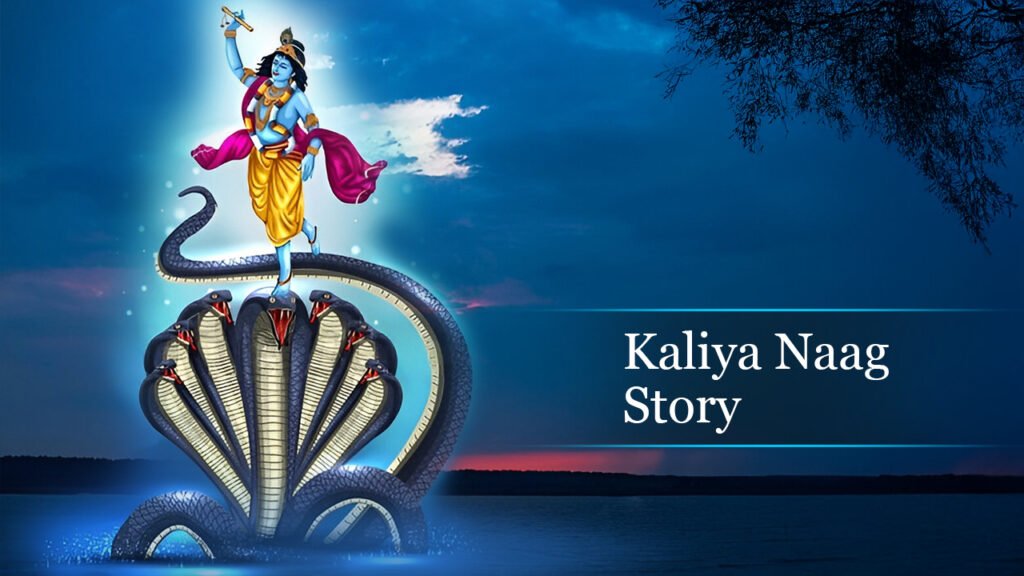Introduction to Kaliya Naag Story
In the rich tapestry of Hindu mythology, few stories captivate the imagination quite like the encounter between Lord Krishna and the fearsome Kaliya Naag Story. This tale, brimming with symbolism and moral lessons, offers a fascinating glimpse into the complex nature of divine justice and mercy. But have you ever wondered why Krishna, known for his righteous actions, chose to spare the life of this cruel serpent? Let’s dive deep into this intriguing narrative and uncover the profound wisdom hidden within.
The Legend of Kaliya Naag
Before we explore Krishna’s decision, let’s set the stage with the legend of Kaliya Naag. Picture a massive, multi-hooded serpent, his very presence enough to strike terror into the hearts of all who crossed his path. Kaliya had made his home in the Yamuna River, turning its waters into a toxic wasteland with his venomous presence. The once-thriving ecosystem around the river had withered, and the local inhabitants lived in constant fear.
Krishna’s Encounter with Kaliya
The Poisoned Yamuna River
Imagine a serene river, once teeming with life, now silent and deadly. This was the state of the Yamuna when Krishna arrived on the scene. The young god, known for his playful nature and love for his people, couldn’t bear to see the suffering caused by Kaliya’s presence.
Krishna’s Brave Intervention
In a display of courage that would become legendary, Krishna decided to confront Kaliya. Picture this: a young boy, seemingly fragile, diving fearlessly into the poisonous waters. The onlookers must have held their breath, fearing the worst. But Krishna was no ordinary child.
The Epic Dance on Kaliya’s Hoods
What followed was a spectacle for the ages. Krishna, with his divine grace, began to dance on Kaliya’s multiple hoods. Each step was a blow, not just physical but spiritual, shaking the very core of the serpent’s being. It was a dance of dominance, of good over evil, of light piercing through darkness.
Read Also: Understanding the Complexity of a Pisces Woman
Krishna’s Merciful Nature
The Power of Compassion
Now, here’s where the story takes an unexpected turn. Just when everyone expected Krishna to deliver the final, fatal blow, he paused. In that moment, we see a glimpse of Krishna’s true nature – not just as a powerful god, but as an embodiment of compassion.
Kaliya’s Plea for Forgiveness
Beaten and humbled, Kaliya recognized the divinity in Krishna. He pleaded for mercy, not just for himself but for his family. It’s a poignant moment that reminds us of the potential for change in even the most seemingly evil beings.
Lessons from Krishna’s Decision
Transformation Through Love
Krishna’s decision to spare Kaliya wasn’t just an act of mercy; it was a profound lesson in the transformative power of love. By showing compassion, Krishna didn’t just save a life – he changed it. Kaliya, once a symbol of terror, became a testament to the possibility of redemption.
The Importance of Second Chances
This story beautifully illustrates the value of second chances. How often in our lives do we write someone off as beyond hope? Krishna’s actions challenge us to see the potential for good in everyone, no matter how far they may have strayed.
Read Also: Vaisakhi 2025- Date and Muhurat of Vaisakhi Festival
Symbolism in the Kaliya Naag Story
Overcoming Inner Demons
On a deeper level, the tale of Kaliya Naag can be seen as an allegory for our inner struggles. Kaliya represents the toxic thoughts and habits that poison our minds and lives. Krishna’s dance symbolizes the spiritual journey we must undertake to overcome these internal demons.
Balance of Justice and Mercy
Krishna’s handling of Kaliya demonstrates a perfect balance between justice and mercy. He punishes Kaliya for his misdeeds but doesn’t destroy him. This balance is a key principle in Hindu philosophy, teaching us that true justice isn’t about revenge but about restoration and growth.
Impact on Hindu Philosophy
The Kaliya Naag episode has had a lasting impact on Hindu philosophy. It’s often cited as an example of the power of divine grace and the importance of compassion in spiritual life. This story encourages believers to approach life’s challenges with a blend of courage and kindness.
Modern Interpretations of the Tale
In today’s world, the story of Krishna and Kaliya continues to resonate. Environmental activists see it as a call to protect our water bodies from pollution. The tale’s versatility speaks to its timeless wisdom.
For interesting astrology-related videos, subscribe to us on YouTube
Conclusion of Kaliya Naag Story
Krishna’s decision not to kill Kaliya Naag is a testament to the power of compassion and the potential for change in every being. It reminds us that true strength lies not in the ability to destroy, but in the courage to show mercy. As we navigate our own lives, may we remember this lesson, finding the balance between justice and compassion, and always believing in the possibility of transformation.
FAQs
- Why is the Kaliya Naag story significant in Hinduism?The story exemplifies Krishna’s divine nature, showcasing his power, wisdom, and compassion. It teaches important lessons about mercy and transformation.
- What happened to Kaliya Naag after his encounter with Krishna?According to the legend, Kaliya left the Yamuna River and relocated to Ramanaka Dwipa, promising never to harm anyone again.
- Does the Kaliya Naag story have any environmental implications?Yes, many interpret the story as an early environmental message, highlighting the importance of keeping water bodies clean and free from pollution.
- Are there any festivals or rituals associated with this story?While there’s no specific festival for this event, the story is often recounted during Krishna Janmashtami celebrations.
- How does the Kaliya Naag episode relate to Krishna’s overall character in Hindu mythology?This episode perfectly encapsulates Krishna’s multifaceted nature – his playfulness, his power, his wisdom, and above all, his boundless compassion.

